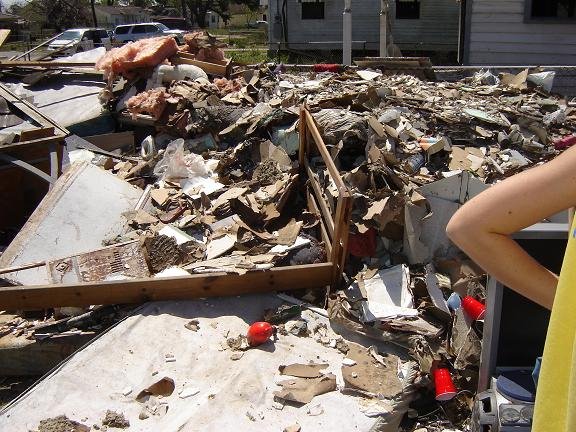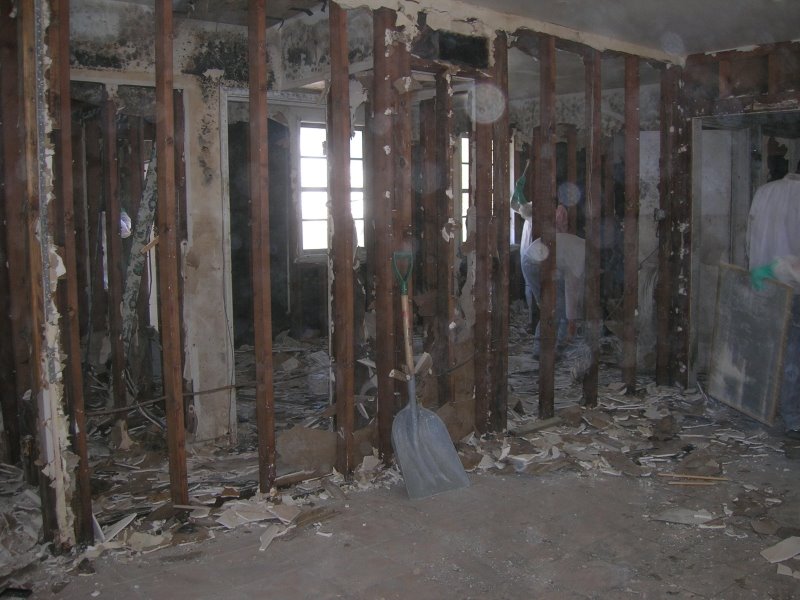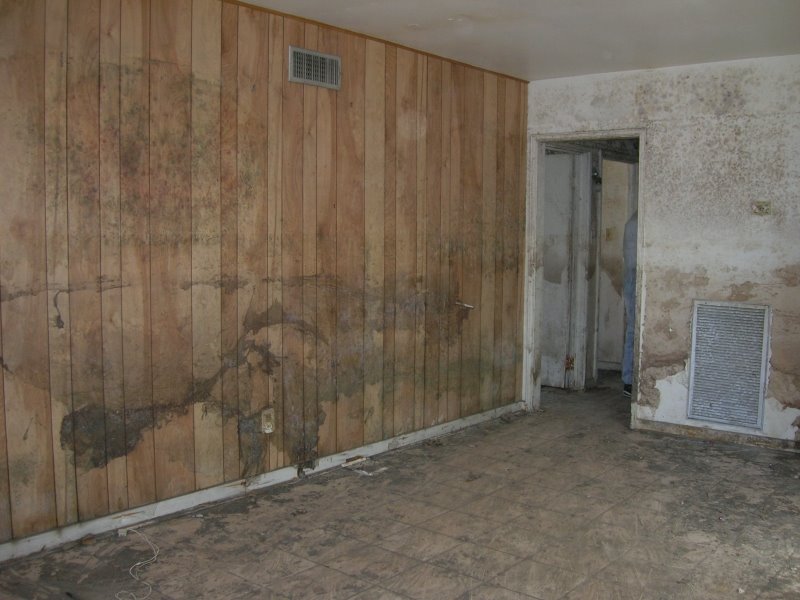Well, ok, over the Grand Canyon and through the airports . . .
to graduation we go.
The Lovely Daughter graduates on Sunday. We leave for the great state of Oregon on Thursday, where we hope to see Lisa, the Columbia River Gorge, Cannon Beach, and ~ oh yeah, a few important events at Willamette University!
It will be tough, to make this trip that for four years I had looked forward to sharing as a family of five. But it will be wonderful, too, to help our beautiful girl celebrate friendships and achievements that began with that fateful hurricane four years ago.
Back in a week or so ~
Showing posts with label NOLA. Show all posts
Showing posts with label NOLA. Show all posts
Tuesday, May 12, 2009
Friday, December 29, 2006
What We Don't Know
The Polar Bear has written a great entry on the topic of our tendency to believe that we understand each other when, in fact, we don't "really know." We think that our own limited experience, leavened with a hefty dose of uninformed opinion, endows us with authority on the lives of others. Polar Bear's plethora of examples caused me to think of a few of my own:
Too young for love? I fell head over heels in love for the first time at the ripe old age of eleven, with the result that my innocent adoration of the smartest boy in the class was dismissed as puppy love. Really dismissed, as I discovered a couple of years ago when I stopped by to see him and my father stared at me blankly when I said, "You don't remember how crazy I was about him? You don't remember how, in that pre-feminist era, I dreamed of becoming Mrs. Adams?" (Morticia, to be exact.)
I went to visit the man in question because I ran into his younger sister and learned where he is. He has been massively disabled by disease and spends his days staring at the television in the nursing home bed to which he is confined. Nevertheless, the wit and intelligence I remember from sixth grade are still lodged in his head as is, I found to my surprise, his memory of me -- the little girl whom an 11-year-old boy could never have admitted to "liking."
That first kiss, engineered over Spin-the-Bottle (which, as we all know, "doesn't count") was long ago, but the feelings were strong enough that I haven't forgotten them.
*****
Too old for grief? My father has been widowed three times and divorced once. After his wife died two years ago, he told me that in some ways it was harder than it had been when he was 28 and lost a child as well, or when he was 38 and lost a wife for the second time in a decade. "At those times," he said, "I had young children to think of, and work to hang onto. Now. . .what?" He has filled his life with his interests and the companionship of friends, but he is not too old to feel the devastation of an empty home in which conversation and laughter once reigned.
*****
Too stubborn for reality? A few nights ago when visiting extended family, we were treated to my brother-in-law's and 14-year-old niece's views on the idiocy of rebuiding New Orleans. "How stupid can people be?" asked the young lady. "They can do whatever they want, but don't ask me to insure it with my tax dollars!" exclaimed her father.
My mild references to NOLA as a significant port city, critical to our economy, and to the fact that it is HOME for thousands of people, made no impression. But then my own 19-year-old daughter began to talk, and her uncle and cousin fell silent.
"When I was volunteering there last spring," she said, "we were working on one house and a guy came around and asked us to talk to a lady at another house. So we walked a couple of blocks and there she was, with all her stuff piled outside, insisting that she wanted to keep it all. 'Ma'am,' we said, as gently as we could, 'you can't keep it. It's all mildewed and ruined and it will make you sick. We really have to take it away.' And she sat there and watched, staring at us, as we put all her wordly possessions into bags to be carted away. She was LIVING ON HER PORCH."
(That would have been six or eight months or so after Katrina.)
*****
No, we don't know.
Too young for love? I fell head over heels in love for the first time at the ripe old age of eleven, with the result that my innocent adoration of the smartest boy in the class was dismissed as puppy love. Really dismissed, as I discovered a couple of years ago when I stopped by to see him and my father stared at me blankly when I said, "You don't remember how crazy I was about him? You don't remember how, in that pre-feminist era, I dreamed of becoming Mrs. Adams?" (Morticia, to be exact.)
I went to visit the man in question because I ran into his younger sister and learned where he is. He has been massively disabled by disease and spends his days staring at the television in the nursing home bed to which he is confined. Nevertheless, the wit and intelligence I remember from sixth grade are still lodged in his head as is, I found to my surprise, his memory of me -- the little girl whom an 11-year-old boy could never have admitted to "liking."
That first kiss, engineered over Spin-the-Bottle (which, as we all know, "doesn't count") was long ago, but the feelings were strong enough that I haven't forgotten them.
*****
Too old for grief? My father has been widowed three times and divorced once. After his wife died two years ago, he told me that in some ways it was harder than it had been when he was 28 and lost a child as well, or when he was 38 and lost a wife for the second time in a decade. "At those times," he said, "I had young children to think of, and work to hang onto. Now. . .what?" He has filled his life with his interests and the companionship of friends, but he is not too old to feel the devastation of an empty home in which conversation and laughter once reigned.
*****
Too stubborn for reality? A few nights ago when visiting extended family, we were treated to my brother-in-law's and 14-year-old niece's views on the idiocy of rebuiding New Orleans. "How stupid can people be?" asked the young lady. "They can do whatever they want, but don't ask me to insure it with my tax dollars!" exclaimed her father.
My mild references to NOLA as a significant port city, critical to our economy, and to the fact that it is HOME for thousands of people, made no impression. But then my own 19-year-old daughter began to talk, and her uncle and cousin fell silent.
"When I was volunteering there last spring," she said, "we were working on one house and a guy came around and asked us to talk to a lady at another house. So we walked a couple of blocks and there she was, with all her stuff piled outside, insisting that she wanted to keep it all. 'Ma'am,' we said, as gently as we could, 'you can't keep it. It's all mildewed and ruined and it will make you sick. We really have to take it away.' And she sat there and watched, staring at us, as we put all her wordly possessions into bags to be carted away. She was LIVING ON HER PORCH."
(That would have been six or eight months or so after Katrina.)
*****
No, we don't know.
Wednesday, April 12, 2006
New Orleans, New Orleans
Monday, March 27, 2006
New Orleans: "A Heck Of A Job"
Saturday, January 28, 2006
Some Things Don't Require Many Words
One of the world's most fanous streets -- quiet on a Sunday morning, but it will rise again.
A t-shirt hanging in a Bourbon Street storefront.
And if you're in the mood for many more words, go here. Jazz great Wynton Marsalis made quite a Martin Luther King Day speech at Tulane University.
Wednesday, January 25, 2006
Formation Out Of Water


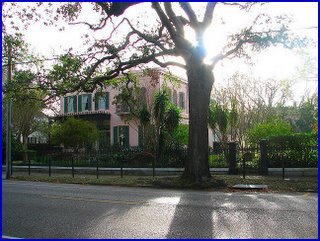
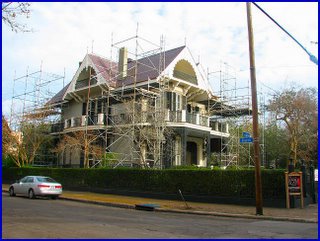
New Orleans, situated above the snake-like curve of the Mississippi River and below the enormity of Lake Ponchartrain, is a city of the water.
When the Americans began to pour into the city after the Louisiana Purchase in 1803, they discovered that the French, long ensconced east of Canal Street, were eager neither to make their acquaintance nor to welcome them into New Orleans society or government. However, there were fortunes to be made as tarriff regulations vanished in the wake of the takeover by the new little American nation and the port of New Orleans opened to trade with Europe, the eastern United States, and the western frontier. The Americans weren't going anywhere. They settled west of Canal Street and began to build their own culture, across from the "neutral zone" where peoples of all nationalities could set up necessary encounters, and a distance from what we know today as the French Quarter.
The small prestigious American enclave benefitted from Mississippi floodwaters of the early 19th century, which deposited a thick layer of silt as they seeped away. The silt destroyed sugar plantations, but created high ground for houses and fertile ground for gardens. Hence, the birth of the Garden District. I was fascinated to learn that a natural and economic disaster not so different from Katrina had created the circumstances under which a neighborhood flourished in the decades following and was largely preserved when, 200 years later, a few inches of ground meant the difference between salvation and inundation.
As is evident from the last photograph, the Garden District did not emerge from Katrina entirely unscathed. The mansion in the bottom picture, encased in scaffolding, exists entirely under the auspices of a historical slate company from Cincinnati at the moment. One of New Orleans' most famous restaurants, Commander's Palace, has a long and difficult comeback ahead -- its sign says "We Understand."
But other homes remain mostly intact, a blue tarp here or there the only obvious sign of what happened. Perhaps there is something to be learned from the results of the flood that created the Garden District.
Sunday, January 22, 2006
Cities of the Dead



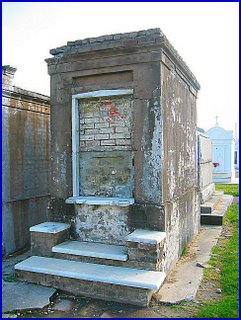 Contrary to many misconceptions, much of New Orleans' history remains intact, despite the devastation wrought by Katrina. Many of the famous above-ground cemeteries, for instance, are in reasonably good shape, including St. Louis Cemetery No. 3, which we visited on a tour arranged by Tulane. (I've just been visiting cemetery websites and learned that under no circumstance should anyone consider a solo visit to a New Orleans cemetery. Good thing I didn't let my natural affinity for cemeteries worldwide lure me back for a private walk. I had no plans to move in permanently.)
Contrary to many misconceptions, much of New Orleans' history remains intact, despite the devastation wrought by Katrina. Many of the famous above-ground cemeteries, for instance, are in reasonably good shape, including St. Louis Cemetery No. 3, which we visited on a tour arranged by Tulane. (I've just been visiting cemetery websites and learned that under no circumstance should anyone consider a solo visit to a New Orleans cemetery. Good thing I didn't let my natural affinity for cemeteries worldwide lure me back for a private walk. I had no plans to move in permanently.)The cemeteries are above-ground for a couple of reasons. The more dramatically appealing has to do with New Orleans' location below sea level, which means that coffins buried underground have a tendency to pop back up during a flood or hurricane. A less dramatic but more likely reason is that above-ground burial was common in France and Spain, the two countries from which many of New Orleans' European residents arrived pre-1800.
For whatever reason, above-ground burial is emminently practical in New Orleans. Although numbers of names frequently appear on the tombs , they usually represent more former than present occupants. There are, after all, only two slots in most of the tombs, each of them usually owned by the same family for decades. The recently departed are buried in wooden coffins, and the intense Louisiana heat causes body and encasement to disintegrate rather quickly, enabling them to be swept into an opening in the floor of the tomb. Cremation in lieu of burial was not permitted by the Catholic church until recently, but "natural" cremation was acceptable.
You can see in the bottom photograph that the tombs are constructed simply, with only one layer of bricks needing to be removed in order to brush away a former occupant in order to install a new set of remains. (The photograph above that portrays the tomb of a Carmelite house of nuns -- many names but few spaces.)
New Orleans law still requires that a body remain in his or her original space for a year and a day -- a carryover from the years of yellow fever epidemics, when people did not know the origins of the disease and feared that the fumes from a decomposing body might be contagious if a tomb were opened too soon.
The tombs are more or less elaborate depending upon the income and status of the owner-families. The walls of the cemeteries contain the budget-rate vaults; the families with wealth produce elbaorate carving and statuary. The cemeteries are immensely interesting, with their lengthy litanies of French names and their village-like quality -- but apparently an official cemetery tour is the only safe way to go.
Thursday, January 19, 2006
Respite
 Southeastern Louisiana is not all turmoil and devastation. Egrets and herons still stalk the bayous, and chickadees and warblers still flit among the cypress and palmettos.
Southeastern Louisiana is not all turmoil and devastation. Egrets and herons still stalk the bayous, and chickadees and warblers still flit among the cypress and palmettos.I'm headed out of town to visit family and take a look at an employment opportunity, and I'm returning Saturday to a stack of papers to grade and a Sunday presentation on Ignatian spirituality for our church adult education class, a church luncheon, and the annual meeting.
So it will be a few days before I pick up my New Orleans series again. If you haven't read it, I hope you'll look back at my week's writing. I'm not participating in NOLA rebuilding, but I'm trying to do what I can by sharing the story as I witnessed it. Please share a comment if any of the entries makes an impact on you.
And a minor update: my daughter seem energized by her first week at Tulane. She's thrilled that her urban sociology class will offer her a chance to do fieldwork in the neighborhoods of her new city along with opportunities for service learning with local agencies. I'm thinking she's doing just fine.
Sunday, December 11, 2005

Death of an American City
New York Times, December 11, 2005
New York Times, December 11, 2005
We are about to lose New Orleans. Whether it is a conscious plan to let the city rot until no one is willing to move back or honest paralysis over difficult questions, the moment is upon us when a major American city will die, leaving nothing but a few shells for tourists to visit like a museum.
We said this wouldn't happen. President Bush said it wouldn't happen. He stood in Jackson Square and said, "There is no way to imagine America without New Orleans." But it has been over three months since Hurricane Katrina struck and the city is in complete shambles.
There are many unanswered questions that will take years to work out, but one is make-or-break and needs to be dealt with immediately. It all boils down to the levee system. People will clear garbage, live in tents, work their fingers to the bone to reclaim homes and lives, but not if they don't believe they will be protected by more than patches to the same old system that failed during the deadly storm. Homeowners, businesses and insurance companies all need a commitment before they will stake their futures on the city.
At this moment the reconstruction is a rudderless ship. There is no effective leadership that we can identify. How many people could even name the president's liaison for the reconstruction effort, Donald Powell? Lawmakers need to understand that for New Orleans the words "pending in Congress" are a death warrant requiring no signature.
The rumbling from Washington that the proposed cost of better levees is too much has grown louder. Pretending we are going to do the necessary work eventually, while stalling until the next hurricane season is upon us, is dishonest and cowardly. Unless some clear, quick commitments are made, the displaced will have no choice but to sink roots in the alien communities where they landed.
The price tag for protection against a Category 5 hurricane, which would involve not just stronger and higher levees but also new drainage canals and environmental restoration, would very likely run to well over $32 billion. That is a lot of money. But that starting point represents just 1.2 percent of this year's estimated $2.6 trillion in federal spending, which actually overstates the case, since the cost would be spread over many years. And it is barely one-third the cost of the $95 billion in tax cuts passed just last week by the House of Representatives.
Total allocations for the wars in Iraq and Afghanistan and the war on terror have topped $300 billion. All that money has been appropriated as the cost of protecting the nation from terrorist attacks. But what was the worst possible case we fought to prevent?
Losing a major American city.
"We'll not just rebuild, we'll build higher and better," President Bush said that night in September. Our feeling, strongly, is that he was right and should keep to his word. We in New York remember well what it was like for the country to rally around our city in a desperate hour. New York survived and has flourished. New Orleans can too.
Of course, New Orleans's local and state officials must do their part as well, and demonstrate the political and practical will to rebuild the city efficiently and responsibly. They must, as quickly as possible, produce a comprehensive plan for putting New Orleans back together. Which schools will be rebuilt and which will be absorbed? Which neighborhoods will be shored up? Where will the roads go? What about electricity and water lines? So far, local and state officials have been derelict at producing anything that comes close to a coherent plan. That is unacceptable.
The city must rise to the occasion. But it will not have that opportunity without the levees, and only the office of the president is strong enough to goad Congress to take swift action. Only his voice is loud enough to call people home and convince them that commitments will be met.
Maybe America does not want to rebuild New Orleans. Maybe we have decided that the deficits are too large and the money too scarce, and that it is better just to look the other way until the city withers and disappears. If that is truly the case, then it is incumbent on President Bush and Congress to admit it, and organize a real plan to help the dislocated residents resettle into new homes. The communities that opened their hearts to the Katrina refugees need to know that their short-term act of charity has turned into a permanent commitment.
If the rest of the nation has decided it is too expensive to give the people of New Orleans a chance at renewal, we have to tell them so. We must tell them we spent our rainy-day fund on a costly stalemate in Iraq, that we gave it away in tax cuts for wealthy families and shareholders. We must tell them America is too broke and too weak to rebuild one of its great cities.
Our nation would then look like a feeble giant indeed. But whether we admit it or not, this is our choice to make. We decide whether New Orleans lives or dies.
Subscribe to:
Posts (Atom)
